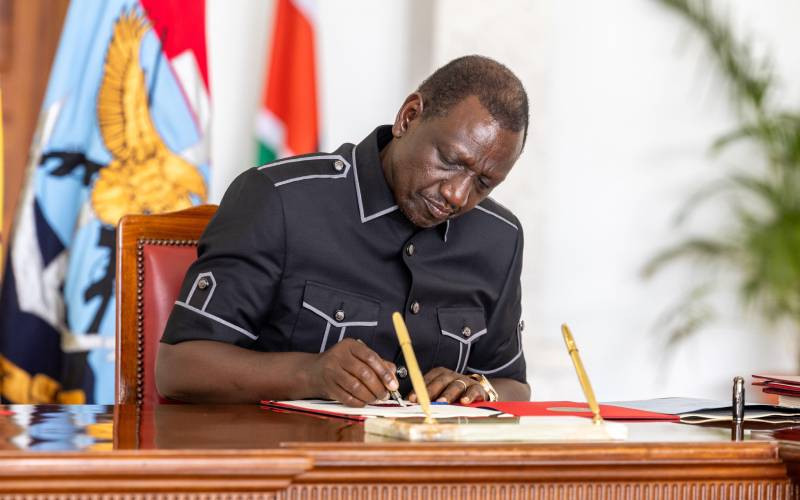Let me start by defining the word “signature” which has been at the centre of logjam between Okoa Kenya team and the Independent Electoral and Boundaries Commission, IEBC. According to Cambridge Dictionary, a signature – is “your name written by yourself, always in the same way, usually to show that something has been written or agreed by you.” It’s further defined as, “a person's name, or a mark representing it, as signed personally or by deputy, as in subscribing a letter or other document.”
While disputing the Okoa Kenya initiative, the IEBC provided Journalists with some representations – which looked like drawings of cats, dogs, cows and some unknown animals. According to IEBC, these were fictitious depictions, and as such were not considered to be signatures. However, going by the definition of signature, these representations are actually signatures and are valid since a signature can be any unique representation including but not limited to drawings. As a matter of fact, the whole idea about writing using hands is simply drawing.
That aside, technically, there is no way IEBC was successfully going to use signatures to verify the supporters of Okoa Kenya Initiative supporters. In fact, it is impossible to use signatures to verify voters or supporters of any initiative. This is because, it will require that IEBC obtains designated signatures for everyone in the country, digitize and use them for any computerized authentication. Patient question here: “which designated signatures did IEBC use to verify the Okoa Kenya signatures?”
According to Article 257(4) of the Constitution states that:
The promoters of a popular initiative shall deliver the draft Bill and the supporting signatures to the Independent Electoral and Boundaries Commission, which shall verify that the initiative is supported by at least one million registered voters.
The section quoted above does not require IEBC to verify signatures, it rather requires that, the people supporting the initiative must undersign to the said support.
This means that the Law only requires IEBC to verify if the people who are said to be supporting the initiative are registered voters. The only way to verify that one is an eligible voter in Kenya is by use of “Corresponding Identifiers” – which are unique in every aspect. Currently, IEBC only has got two corresponding identifiers, the National Identification Numbers and the biometric fingerprints.
In other words, IEBC was supposed to digitize all ID numbers provided in the hardcopy Okoa Kenya Initiative lists, and run them on a software that will match the IDs to the designated list of ID numbers that had been captured during registration of voters. This process will take less than one minute, and the commission shall have known the genuinely registered voters in the Okoa Kenya list.
For example, my grandmother did not get formal education and is unable to read or write. She is however a Kenyan, and an eligible voter. By locking her out of voter process simply because she can’t sign a signature is unethical and unfair. IEBC can however use her ID card number to verify if my grandmother is a genuine voter.
It was rather baffling to watch IEBC officials define nine steps which they undertook to verify the list of the supporters of referendum. “We verified among other details, the names that were submitted in the booklets,” said IEBC Vice Chairperson, Mrs Lilian B. Mahiri-Zaja. The worst mistake was to use people’s names as identifiers. This is because there are millions of Kenyans with the same names across the country, and such a process would lead to serious conflicts in the system.
Any techno-savvy approach will only require three stages for the entire process to be successful, and they include digitization of details, reconciliation of facts and verification of ID numbers to find out if they match those in the voters register. According to IEBC, even after verifying the ID numbers, they continued with the process which was relatively unnecessary.
 The Standard Group Plc is a
multi-media organization with investments in media platforms spanning newspaper
print operations, television, radio broadcasting, digital and online services. The
Standard Group is recognized as a leading multi-media house in Kenya with a key
influence in matters of national and international interest.
The Standard Group Plc is a
multi-media organization with investments in media platforms spanning newspaper
print operations, television, radio broadcasting, digital and online services. The
Standard Group is recognized as a leading multi-media house in Kenya with a key
influence in matters of national and international interest.
 The Standard Group Plc is a
multi-media organization with investments in media platforms spanning newspaper
print operations, television, radio broadcasting, digital and online services. The
Standard Group is recognized as a leading multi-media house in Kenya with a key
influence in matters of national and international interest.
The Standard Group Plc is a
multi-media organization with investments in media platforms spanning newspaper
print operations, television, radio broadcasting, digital and online services. The
Standard Group is recognized as a leading multi-media house in Kenya with a key
influence in matters of national and international interest.







